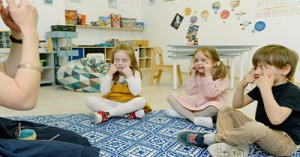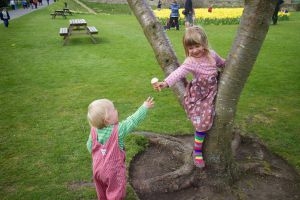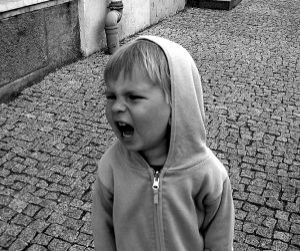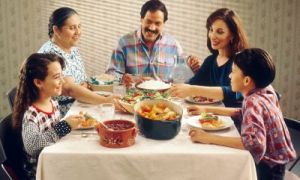Consequences are one of the most effective principles of behaviour management in ECEC settings, as they show children the probable results of their own actions. There are two types of consequences used most often – natural and logical. The following article provides information on Natural consequences, How To Use Natural consequences, Logical consequences and more.
Natural Consequences
These include actions that will inevitably result from certain behaviours of children if adults do nothing to intervene. Instead of adults, natural or social laws impose the consequence on the child. This helps children realise that their actions have automatic, often unpleasant, consequences and if they wish to avoid such results, they better not behave in certain ways. Used judiciously, natural consequences might lead children to learn to take responsibility for what they do.
Here are some examples of natural consequences:
- If they hurt another child, the child will no longer want to play with them.
- If they are wasteful with resources like crayons, they will run out.
- If they are rough with equipment, it will break.
- If the child is left to throw sand, they may hurt other children.
- If the child continues to be rough with other children, there will be injuries and complaints.
- If the child doesn’t complete their homework, your child fails the assignment.
- If the child breaks a rule on the sporting field, your child gets sent off.
- If the child doesn’t wear a hat outside, they will get sunburnt.
- If they throw a ball on the roof, they will have no ball to play with.
How To Use Natural Consequences
For natural consequences to be effective as a behaviour guidance strategy, children need to understand what – usually the unpleasant result – has happened and that it has happened as the natural effect of their own actions. Usually, such understandings have to be mediated by adults for children to really process their own responsibility in the chain of events. For example, in the last example, the educator will have to talk to the child to explain what has happened, and why, like ‘Ben, now the ball is on the roof there are no balls to play with. Josie does not come to get the balls off the roof until Friday, so you will have to wait until then.’ This helps the child to see that the unpleasant situation – no ball to play with – is the natural consequence of his own action – throwing the ball on the roof, thereby supporting them in the decision to avoid such actions in future.
Natural consequences are usually unpleasant and adult caregivers might feel bad for a child when they experience it. For example, if a child, despite repeated suggestions, refuses to eat their snack, then natural consequences require that they go without it. Much as you are tempted to say, ‘I told you so’, it is best to avoid such responses. This is because the point of the strategy is for the child to learn that negative actions will have negative consequences. Responses like, “I told you so”, shift the focus from the child’s own experience to the adult speaker and their higher authority and ‘wisdom’. If the child is open to talking, it might be better to say something like, ‘What do you think you could do differently next time?’
To avoid feeling guilty about imposing a natural consequence, adult caregivers often end up interfering in which case, natural consequences do not work at all. For example, by fixing a later meal after a child refuses to eat dinner, you will stop the natural consequence of hunger. You will also be encouraging the unacceptable behaviour by responding with special attention. Similarly, by forcing your child to wear a coat, they will not experience the natural consequence of feeling cold.
Drawbacks Of Natural Consequences
Though natural consequences are not punishments, they can often be unsafe or inappropriate for children. It is important to understand that children do not have the experience or even scientific knowledge to fully understand the natural consequences of all of their actions. Therefore, it may seem harsh for them to face natural consequences, especially when they have outcomes that are risky. For example, if a child refuses to put on a coat, then natural consequences require that the child go outdoors without one in which case they will feel cold and may even come down with an illness. In this case, enforcing a natural consequence may result in physical or emotional harm to the child, precluding its use in the ECEC setting.
Often a child's misbehaviour can be encouraged by a natural consequence. For instance, shoplifting without being caught results in free clothes and tempts them to repeat the behaviour. Something that adults see as unpleasant, like cold hands, may not matter to your children and therefore is unlikely to deter actions such as not wearing gloves when going out to play.
Again, natural consequences may lead to dangerous or antisocial behaviour, if a child continues to be rough with playmates, it will probably result in others getting hurt. Also regularly allowing natural consequences in some situations can end up causing more harm than good. For example, both the undesirable behaviour – not doing homework – as well as its natural consequence - failing a test – will combine to hamper a child’s learning. In these situations, it is unwise to keep ignoring the child’s behaviour, on the assumption that natural consequences will motivate them to change their ways, and it is better that adult caregivers need to step in to guide the child.
Logical Consequences
In order to avoid the drawbacks of natural consequences, it may be better to use logical consequences. These show children the rational result of their undesirable behaviours. Such results are unappealing to children and thereby guide children to adopt desirable behaviours. An essential characteristic of logical consequences is that the result is directly linked to undesirable behaviour. Examples of logical consequences include:
- if the child throws sand on others, they need to leave the sandpit
- if the child hurt others, they need to work alone
- if the child takes their hat off, they need to go inside
- If the child intentionally makes a mess on the dining table, they must wipe it up.
- If the child leaves their bike in the driveway, the bike gets put away for an hour.
- If children are fighting over a toy, the toy is put away for 10 minutes.
Another characteristic of logical consequences is that though they occur as a result of a child’s actions, they are carried out by the parent or caregiver as a follow-up. Unlike natural consequences, therefore, logical consequences bear the imprint of adult intervention. Indeed it is this room for adult intervention that reduces the potential of harm – for example, if a child keeps throwing sand at others in the sand-pit, then natural consequences would involve others getting hurt before they refuse to play with the child which is the fallout that might motivate the child to mend their ways. On the other hand, imposing a logical consequence would involve an educator asking the child to leave the sandpit, thereby reducing the likelihood of other children getting hurt.
There are two common consequence-based strategies used to guide children’s behaviour, which may or may not be logically linked to a child’s undesirable actions. These include:
- Loss of privilege – this involves taking away a favourite object or activity for a while because of unacceptable behaviour on the part of the child. For example, if a child swears, the educator might prevent the child from using a favourite resource like the computer. Or a child who isn’t cooperating with chores at home might lose the privilege of a lift to soccer training. Loss of privilege works better with older than younger kids.
- Time-out – Also known as quiet time, this involves removing a child away from activities and other people for a short period of time. This works well with younger kids when it might help them to take a break from other people or activities to calm down, for example when they are having a tantrum.
What To Keep In Mind When Using Logical Consequences
- Awareness of rules – since logical consequences are interventions by adults and not natural outcomes, it helps if the rules are explained well in advance to children. Once the child knows what to expect and why they’re more likely to accept the consequences and less likely to feel angry about it. For example, ‘When you don’t share your toys, the toys get put away
- A direct link between cause and effect - Children need to understand that the unwanted consequence is related to their misbehaviour. Once adults show them how their actions are clearly connected to the outcome, children will be able to understand that they have a choice in their behaviour.
- Age-appropriate consequences – When enforcing logical consequences to undesirable behaviour, adults need to ensure that the consequences are age appropriate. For instance, the time-out strategy should follow the rule of approximately one minute per year of age. Again when taking away a privilege, for example, a favourite toy, it should be given back to the child after an appropriate time, so the consequence can be enforced again—especially if it had the desired outcome. Thus in case of rough play by a four-year-old, the favourite toy may be taken away for three-four days but not a month. It is especially important to use mild consequences when imposing logical consequences on young children.
- Allow agency - When possible, allow a child to choose the consequences of their undesirable actions. For example, if an older child dawdles in class, then the educator could explain why they are concerned about the task not being completed and then ask the child what they think would be an appropriate consequence if they did not complete their task, like, “You can finish your work and then play with your friends or you can choose to not play with your friends today”. However, the adult – educator or parent – should ultimately have the final say in this process.
How To Put Consequences In Action
- Consider if it is required - Children younger than three don’t really understand consequences, since the connection between their actions and the outcomes of those actions is not always clear at that level of cognitive development. Also natural consequences, even for children above three, may not always be a good idea since a caregiver’s first priority is to protect the child from any harm.
- Stay calm – the first step in imposing consequences is to remain calm. If you fly into a rage or give in to anxiety, the child will end up connecting their actions to your reaction, rather than the upcoming consequence.
- Offer a start over – If possible, give the child a chance to change their behaviour. For example, ‘Frank, if you take Jay’s turn again, you’ll miss your turn in the next round. However this would not apply to the most important rules like hitting others, in which case you might say something like, ‘We touch each other gently in this room. Hitting means you go straight to time-out’.
- Follow through – For consequences to work, it is important that children know they cannot get out of it. So for instance, if a child has ignored previous warnings, you might say, ‘Frank, I warned you about taking turns. You can sit out of this round’. Also, the consequence should be enforced promptly so that the child makes the connection between their misbehaviour and the consequence.
- Keep it short – the whole point of using consequences is to get children to behave better in future and keeping consequences short gives children an opportunity to prove that they have got the point. For example, if you turn off the TV for 10 minutes because children are fighting over the remote control, they quickly get another opportunity to solve the problem in a different way. Indeed long drawn-out consequences can end up being worse for the supervising adult than for your child. For example, a child deprived of their bike for a week is likely to get bored and cranky.
- Be fair – while keeping consequences age-appropriate, see that they are applied fairly to all. Nothing will erode a child’s trust in an educator faster than finding out that there are different rules for different children.
Further Reading
Logical Consequences - The following article provides information on logical consequences, the steps involved, selecting logical consequences and more.
Redirecting Children's Behaviour - The following article provides information on How Redirecting Behaviour Help, Types Of Redirecting Behaviour, Redirecting Behaviour Strategies and more.
Talking To Parents About Their Child's Behaviour Issues - The following provides information for Educators on how to talk to parents about their child's behavioural issues.
Stages Of Behaviour - The following article provides information on ages and stages of behaviour from infants to preschoolers and strategies to support each age.
References:
Natural Consequences, Raising Children
Natural and Logical Consequences Aspire Solutions







 Working as a childcare professional can be a challenge especially when dealing with behavioural problems which may arise. The techniques we use when dealing with
Working as a childcare professional can be a challenge especially when dealing with behavioural problems which may arise. The techniques we use when dealing with There are different types of behaviour that children can display and sometimes it can be hard to manage, especially if a child is having behavioural
There are different types of behaviour that children can display and sometimes it can be hard to manage, especially if a child is having behavioural As a parent, your behavioural expectations of your child can be higher than what is actually developmentally appropriate for your child's age.
As a parent, your behavioural expectations of your child can be higher than what is actually developmentally appropriate for your child's age.
 As Educators, there will be many instances where you will need to write about a child's behaviour. For a behaviour management plan, assessments, half-yearly or
As Educators, there will be many instances where you will need to write about a child's behaviour. For a behaviour management plan, assessments, half-yearly or As Educators when communicating with Parents (through verbal or non-verbal communication), there will be times where we need to discuss issues or concerns that may
As Educators when communicating with Parents (through verbal or non-verbal communication), there will be times where we need to discuss issues or concerns that may Challenging Behaviour is when a child does something that hurts themselves and/or other people.
Challenging Behaviour is when a child does something that hurts themselves and/or other people.
 As part of your child's development it is normal for your child to have anxiety and fears. A baby commonly shows a fearful sign to
As part of your child's development it is normal for your child to have anxiety and fears. A baby commonly shows a fearful sign to It's always difficult to bring up behavioural issues with parents, it can be nerve wrecking to tell a parent that their child misbehaves but that
It's always difficult to bring up behavioural issues with parents, it can be nerve wrecking to tell a parent that their child misbehaves but that All children deal with anger on a daily basis. Thinking about it as a child, there is a lot to be angry about. Elder people
All children deal with anger on a daily basis. Thinking about it as a child, there is a lot to be angry about. Elder people It is important to understand that your child behaviour problems could not just be from attention seeking. There are many factors to take into consideration
It is important to understand that your child behaviour problems could not just be from attention seeking. There are many factors to take into consideration


